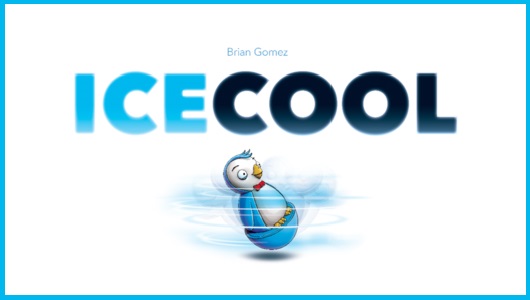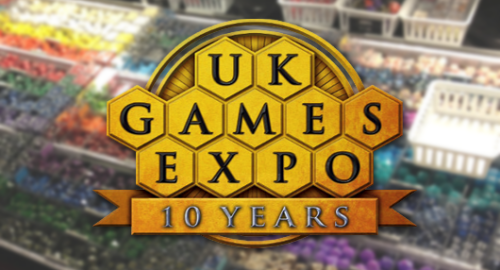Ice Cool was one of the more noticeable games of UK Games Expo 2016, winning a Best Children’s Game award as the expo closed. In essence it is a dexterity flicking game, where players use flicking penguin pieces to chase each other across the board. It is primarily a children’s game, but there is absolutely no reason why adults wouldn’t enjoy, and, indeed, I have first-hand proof that they do.
• Designer: Brian Gomez
• Publisher: Brain Games
• Number of Players: 2-4
• Playing Time: 30 mins

Whenever I talk about Ice Cool, I can’t help but mention another game, which is its very close relative, if not parent: Crokinole. Similarly it is also a dexterity flicking game, a shuffleboard and curling game mashed together and reduced to table-top size. Players flick counters of their chosen colour aiming to get in the centre, or as close to as possible, on a circular board. Players use counters to push the counters of their opponents away from the centre and off the board. After everyone has run out of counters, the points are calculated, the inner circles of the board being more valuable than the outer, and a player with most points wins.
Now turn to Ice Cool. Here the counters are penguins pieces, with which players are aiming to flick through door openings to collect fish. While another player, the penguin chaser, tries to catch them before the fish is collected by flicking their piece into them. While Crokinole is abstract, pure and stripped down to the bare basics, Ice Cool takes exactly the same elements and adds a bit of character to it (penguin theme) for a greater player appeal, but also a few extra bits on top. Some of these additions could be considered superfluous, or as something fun and silly, adding a bit more flavour to the game. It is simply a matter of your gaming preference. Having said that, there are a few interesting additions to Ice Cool that make it stand out that are important to note.
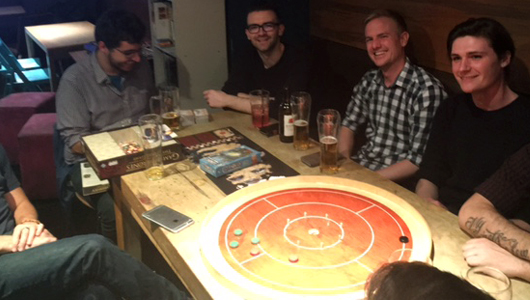
Crokinole at TableTop Tuesday
There is a lot more to flicking that you might think! The pieces were designed in such a way, that with the right skills, they can slide, curve, dive or jump. The more you play, the better you get at controlling the movement trajectory and the more complicated (and impressive!) things you could do. Ice Cool is a skill based game, and the player who has a better hand coordination will tend to win (or should, more on that to follow). The enjoyment of the game, however, is not at all tied to winning. Flicking games are just as fun to win as they are to lose. There is equal, if not more, satisfaction to be gained from an atrociously bad flick than from a really good one. Whether you are playing to get better or just for fun, the game will be enjoyable.
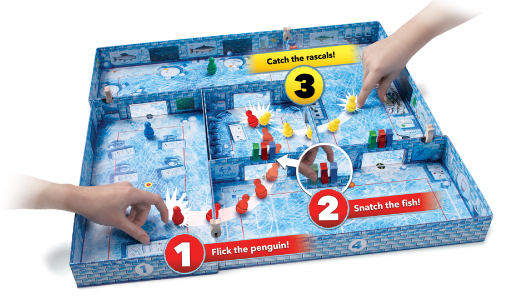
The board itself is also quite interesting – for me, the setting up, probably more so, than the layout itself. The board is actually several different sized boxes arranged together, and held by custom designed pins. When stored away, boxes fit into each other Russian doll style, and thus take up just as much space as a normal large game box, while offering a much bigger flicking field when assembled for the game. Each box is a room, or a classroom in a penguin school, with openings linking them all together. Penguins will have to slide through certain door openings to get the fish and so collect points in order to win the game. To make it fair for those players who are collecting fish and for those are chasing the penguins, there is only one room layout. While to me this is a shame, I can easily see an Ice Cool expansion coming out offering other layouts as well or expanding the board.
The winner of Ice Cool is decided based on points, which are earned by catching fish or obtaining penguin students’ identity cards. Every player starts the game with an identity card, but the chaser player takes the card from those penguins he has caught. The points are displayed on separate cards, which are shuffled and drawn at random, and the value of points range from 1 to 3. Another strategic element to the game is that a player can display two cards worth 1 point each for a second flick.
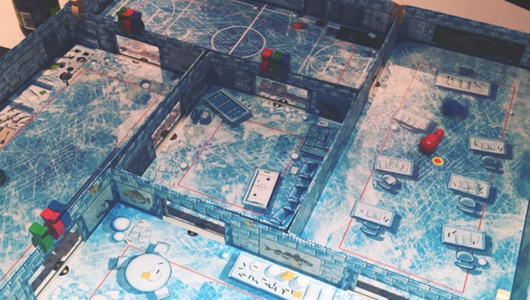
This point system is my only real gripe with the game. It seems strange to me that a game that relies heavily on skill leaves the winning up to luck. A player can be really good and only pick up cards worth one point throughout their whole game. While another player, who is not as skilful but luckier could get a couple of cards worth 3 points and win the game. There is some mystery and excitement to revealing and counting points at the end of the game, but it does not always feel satisfying.
However, at the end of the day you have to consider which audience Ice Cool is aiming at and what it is trying to achieve. For one, it never tries to present itself as deeply strategic or even a serious competitive game. You play it to flick cute penguin figurines and laugh at the successes and failures. It is easy to learn and quick to set up and pack. I can easily see both children and adults enjoying the game, together and separately, and bonding over the experience of playing it.
